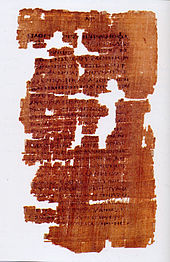Second Apocalypse of James
| hide |
|---|
 |
The Second Apocalypse of James is a 2nd century A.D. apocalyptic text of the Nag Hammadi library which describes the trial and martyrdom of James the Just.
Origin of the Document[]
The Second Apocalypse of James is the fourth tractate placed right after the First Apocalypse of James of what is now known as Codex V.[1] It is believed to have been written around the second century CE, and then buried and lost until it was rediscovered amongst 52 other Gnostic Christian texts spread over 13 codices by an Arab peasant, Mohammad Ali al-Samman, in the Egyptian town of Nag Hammadi late in December 1945.
The gnostic text contains many Jewish-Christian themes, making many scholars think it to be one of the earlier texts, originally from the early or mid-second century.[2] One of the most curious features of the second apocalypse of James is that this range of dating, of its original text, assigned to it by scholars, requires that it was written before the First Apocalypse of James.
The Relationship Between James and Jesus[]
A number of differences are seen from the more canonical history that the text describes. For example, it names James' father Theudas rather than Joseph, who is presented as the biological father of James by the mid-second-century Gospel of James. Notably, the names Theudas and Alpheus (father of James the Less) have similar meanings. The name 'Theudas' means "flowing with water",[3] and the Greek name 'Alpheus' means "changing"[4] or "god of the rivers".[5]
The wife of this Theudas is named Mary; whether or not this Mary is the same woman as the mother of Jesus, and whether this Mary is supposed to be the biological mother of James, is never explicitly stated in the text.
The First Apocalypse of James explicitly claims that James and Jesus are not biological brothers. In contrast, the Second Apocalypse of James (which was likely written prior to the "First" Apocalypse of James)[6] states that Jesus and James share the same mother, presumably being Mary.
- Once when I was sitting deliberating, he (Jesus) opened the door. That one whom you hated and persecuted came in to me. He said to me, "Hail, my brother; my brother, hail." As I raised my face to stare at him, (my) mother said to me, "Do not be frightened, my son, because he said 'My brother' to you. For you were nourished with this same milk. Because of this he calls me "My mother". For he is not a stranger to us. He is your step-brother [...].
It then explains that they have different biological fathers.
- <You are> the one to whom I say: Hear and understand - for a multitude, when they hear, will be slow witted. But you, understand as I shall be able to tell you. Your father is not my father. But my father has become a father to you.
James, "My Beloved"[]
The text features a kiss between James and Jesus, on the lips, in a similar manner to the way in which Jesus is said to have kissed Mary Magdalene in the apocryphal Gospel of Phillip.[7]
- And Jesus kissed my mouth. He took hold of me saying: 'My beloved! Behold, I shall reveal to you those things that the heavens nor the angels have known. Behold, I shall reveal to you everything, my beloved. Behold, I shall reveal to you what is hidden. But now, stretch out your hand. Now, take hold of me'.
However, the text also describes how such a kiss was a metaphor for the passing of gnosis, explaining the references to it elsewhere, making it clear that this is not the homosexual relationship it might appear to be.
James Tabor cites Jesus referring to James as "my beloved" (twice) in this passage as evidence for James being the Beloved Disciple.[8]
Martyrdom of James[]
The text ends with the rather gruesome death of James by stoning, possibly reflecting an early oral tradition of what became of James:
- They decided to throw him down from the height, and they cast him down... They seized him and struck him as they dragged him on the ground. They stretched him out and placed a stone on his abdomen. They all placed their feet on him, saying: 'You have erred!' Again they raised him up, since he was alive, and made him dig a hole. They made him stand in it. After having covered him up to his abdomen, they stoned him.
References[]
- ^ Brown, S. Kent (July 1975). ""Jewish and Gnostic Elements in the Second Apocalypse of James (CG V, 4)" Novum Testamentum Vol. 17, Fasc. 3". Novum Testamentum. Provo, Utah: BRILL. 17 (3): 225–237. doi:10.2307/1560057. JSTOR 1560057.
- ^ Wilhelm Schneemelcher, ed., translation by R. McL. Wilson, New Testament Apocrypha : Gospels and Related Writings (Louisville: John Knox Press, 1992), pp. 327-341
- ^ Hitchcock, Roswell D. (1874). "Hitchcock's Bible Names Dictionary". A.J. Johnson. Retrieved 2007-04-16.
- ^ "Alphaeus".
- ^ "Alpheus name meaning".
- ^ Wilhelm Schneemelcher, ed., translation by R. McL. Wilson, New Testament Apocrypha : Gospels and Related Writings (Louisville: John Knox Press, 1992), pp. 327-341
- ^ "Gospel of Philip".
- ^ Tabor, James D (2006). The Jesus Dynasty: A New Historical Investigation of Jesus, His Royal Family, and the Birth of Christianity. Simon & Schuster. ISBN 978-0-7432-8723-4.
Sources[]
- Christian apocalyptic writings
- Apocryphal revelations
- 2nd-century Christian texts
